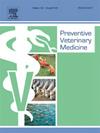瑞典应对非洲猪瘟疫情措施的收益和成本。
IF 2.2
2区 农林科学
Q1 VETERINARY SCIENCES
引用次数: 0
摘要
在许多国家,减轻非洲猪瘟(ASF)危害的一个通用规则是在疫情爆发时消灭病毒,以防止病毒扩散,并避免因消灭受感染的家猪而产生的相关社会成本。通过五种不同的评估标准(净现值、效益成本比、收益率、内部收益率和投资回收期)来衡量这种做法的经济效益,取决于控制成本的类型以及效益的空间和动态分配,即避免受感染家猪养殖场的损失。本文计算了瑞典中部野猪 ASF 爆发期间立即采取控制措施的直接和间接成本。直接成本包括监控、实验室检测、野猪绝育等费用,而间接成本则由该地区的企业和居民承担,与行动限制有关。计算显示,控制措施的总成本为 2,800 万欧元,其中间接成本占 40%。效益在很大程度上取决于 ASF 的扩散速度和养猪户的投资反应假设,这意味着五项评估标准中的每一项都存在很大差异。本文章由计算机程序翻译,如有差异,请以英文原文为准。
Benefits and costs of measures to tackle the outbreak of African swine fever in Sweden
A common rule in many countries for mitigating the damage caused by African swine fever (ASF) is to eradicate the virus at the outbreak in order to prevent its dispersal and the associated social costs of depopulating infected domestic pigs. The economic performance of this practice, as measured by five different evaluation criteria (net present value, benefit-cost ratio, rate of return, internal rate of return, and payback time), depends on the type of control cost and the spatial and dynamic allocation of benefits, i.e. avoided losses from infected domestic pig farms. The present paper calculates the direct and indirect costs of immediate control measures during an ASF outbreak in wild boars in Mid Sweden. The direct costs include expenses incurred for surveillance, laboratory tests, depopulation of wild boar etc., while the indirect costs are borne by firms and people in the area in relation to movement restrictions. The calculations showed that the total cost of control measures amounted to 28 million euros, with indirect costs making up 40 % of this figure. The benefits were greatly dependent on the speed of ASF dispersal and assumptions about pig farmers’ investment responses, which implied large variations in each of the five evaluation criteria.
求助全文
通过发布文献求助,成功后即可免费获取论文全文。
去求助
来源期刊

Preventive veterinary medicine
农林科学-兽医学
CiteScore
5.60
自引率
7.70%
发文量
184
审稿时长
3 months
期刊介绍:
Preventive Veterinary Medicine is one of the leading international resources for scientific reports on animal health programs and preventive veterinary medicine. The journal follows the guidelines for standardizing and strengthening the reporting of biomedical research which are available from the CONSORT, MOOSE, PRISMA, REFLECT, STARD, and STROBE statements. The journal focuses on:
Epidemiology of health events relevant to domestic and wild animals;
Economic impacts of epidemic and endemic animal and zoonotic diseases;
Latest methods and approaches in veterinary epidemiology;
Disease and infection control or eradication measures;
The "One Health" concept and the relationships between veterinary medicine, human health, animal-production systems, and the environment;
Development of new techniques in surveillance systems and diagnosis;
Evaluation and control of diseases in animal populations.
 求助内容:
求助内容: 应助结果提醒方式:
应助结果提醒方式:


